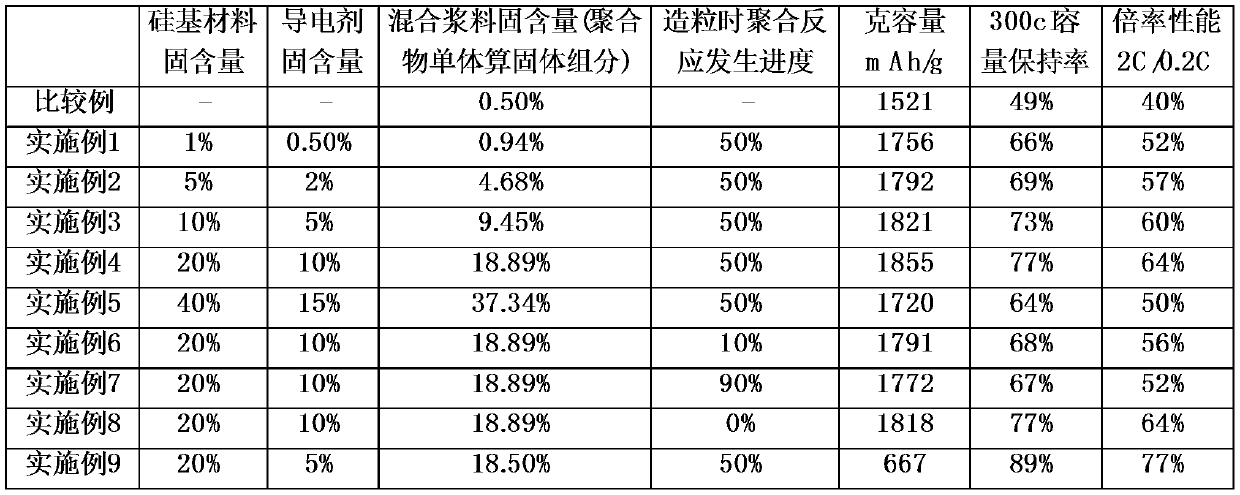A kind of silicon carbon negative electrode material and preparation method thereof
A negative electrode material, silicon carbon technology, applied in the direction of battery electrodes, structural parts, electrical components, etc., can solve problems such as disconnection, affecting the electrochemical performance of silicon carbon materials, weak adhesion, etc., to reduce energy consumption and solid content The effect of increasing and reducing the dosage
- Summary
- Abstract
- Description
- Claims
- Application Information
AI Technical Summary
Problems solved by technology
Method used
Image
Examples
Embodiment 1
[0037] Embodiment 1, the difference from the comparative example is that this embodiment includes the following steps:
[0038] Step 1. Kneading: Combine elemental silicon, methyl methacrylate and tetraethoxysilane with a particle size of 100nm (the mass ratio is: elemental silicon: methyl methacrylate: tetraethoxysilane = 90:4:1 ), NMP (solid content is 1%) and kneaded after mixing, the revolution is 60 revolutions / min, the rotation is 500 revolutions / min; kneading for 2 hours to obtain mixture 1; the conductive carbon black, polyvinylpyrrolidone (the mass ratio is conductive carbon black: Polyvinylpyrrolidone=4.9:0.1) and NMP (solid content of 0.5%) are mixed and kneaded, the revolution is 60 revolutions / min, and the rotation is 500 revolutions / min; kneading 2h to obtain mixture 2; mix mixture 1, mixture 2 (mass ratio Is elemental silicon: conductive carbon black=90:4.9) mix together, continue kneading, revolution is 20 revolutions / min, rotation is 300 revolutions / min; after kn...
Embodiment 2
[0043] The second embodiment is different from the first embodiment in that this embodiment includes the following steps:
[0044] Step 1. Kneading: Combine elemental silicon, methyl methacrylate and tetraethoxysilane with a particle size of 100nm (the mass ratio is: elemental silicon: methyl methacrylate: tetraethoxysilane = 90:4:1 ), NMP is mixed (solid content is 5%) kneading, revolution is 20 revolutions / min, rotation is 300 revolutions / min; kneading 2h to obtain mixture 1; Conduct conductive carbon black and polyvinylpyrrolidone (the mass ratio is conductive carbon black: Polyvinylpyrrolidone=4.9:0.1) and NMP (solid content is 2%) after kneading, revolution is 20 revolutions / min, rotation is 300 revolutions / min; kneading 2h to obtain mixture 2; mix mixture 1, mixture 2 (mass ratio Is elemental silicon: conductive carbon black=90:4.9) mix together, continue kneading, revolution is 20 revolutions / min, rotation is 300 revolutions / min; after kneading for 2 hours, polymer monomer...
Embodiment 3
[0048] Embodiment 3 is different from Embodiment 1 in that this embodiment includes the following steps:
[0049] Step 1. Kneading: Combine elemental silicon, methyl methacrylate and tetraethoxysilane with a particle size of 100nm (the mass ratio is: elemental silicon: methyl methacrylate: tetraethoxysilane = 90:4:1 ), after mixing NMP (solid content is 10%) kneading, revolution is 10 revolutions / min, rotation is 100 revolutions / min; kneading 4h to obtain mixture 1; combine conductive carbon black and polyvinylpyrrolidone (the mass ratio is conductive carbon black: Polyvinylpyrrolidone=4.9:0.1) and NMP (solid content is 5%) after kneading, revolution is 10 revolutions / min, rotation is 100 revolutions / min; kneading 4h to obtain mixture 2; mix mixture 1, mixture 2 (mass ratio Is elemental silicon: conductive carbon black = 90:4.9) mix together, continue kneading, revolution is 20 revolutions / min, rotation is 100 revolutions / min; kneading 4h to obtain polymer monomer, nano silicon-b...
PUM
| Property | Measurement | Unit |
|---|---|---|
| diameter | aaaaa | aaaaa |
| particle diameter | aaaaa | aaaaa |
Abstract
Description
Claims
Application Information
 Login to View More
Login to View More - R&D
- Intellectual Property
- Life Sciences
- Materials
- Tech Scout
- Unparalleled Data Quality
- Higher Quality Content
- 60% Fewer Hallucinations
Browse by: Latest US Patents, China's latest patents, Technical Efficacy Thesaurus, Application Domain, Technology Topic, Popular Technical Reports.
© 2025 PatSnap. All rights reserved.Legal|Privacy policy|Modern Slavery Act Transparency Statement|Sitemap|About US| Contact US: help@patsnap.com

